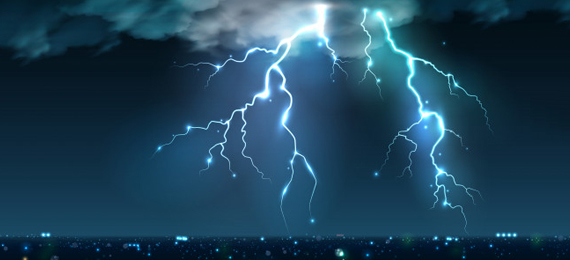
Have you ever wondered why lightning occurs and how it is formed? Some people find it frightening but there are several interesting facts about lightning. In this article, you will get to know many interesting thunder and lightning facts.
What Is Lightning?
Lightning is an electrostatic discharge that occurs between the cloud and the earth or within the clouds. It is caused when frozen drops in the skies collide causing an electrostatic discharge. It causes a sudden release of a large amount of energy and it is accompanied by a bright flash.
Do you wanna learn more lightning storm facts and information? We have listed interesting facts about lightning for you!
1. The Glass-Like Structure That Is Formed When the Lightning Hits the Sand Is Called Fulgurite.
- A. True
- B. False
- Does lightning leave a mark on the ground? Yes, it does. When lightning strikes the soil or rock, it fuses together with the minerals to form a small glass-like tube called fulgurite. Though it can be found worldwide, they are considered very rare and have great scientific importance. Their structure is almost similar to Lichtenberg’s figures.
- Astraphobia is a fear of getting hit by lightning although the chances are very less (only 1 in 15, 000), astraphobia is the third most common type of phobia in America. The odds of becoming a victim to lightning per year is 1 in 1,200, 000. There are several ways people can get affected by lightning as it depends on how the lightning strikes. Direct strike, side strike, ground current, and conduction. Though cell phones do not attract lightning, the majority of the people get hit by lightning while using cell phones.
- Around the world, an average of 100 lightning bolts per day is recorded which results in 8 million strikes per day and 3 billion every year.
- Lightning can have adverse reactions to trees. When lightning strikes a tree it only hits below the bark which is a layer of sap and water. When the lightning hits this layer it instantly heats up making the bark to cut-off from the tree. When the heat travels through the tree it vaporizes the sap and creates steam and makes the trunk explode.
- How wide is the average lightning bolt? The actual width of a lightning bolt can be around 2 to 3 cm and the average length can be 2 to 3 miles. It might look bigger to our eyes because it is very bright and sometimes multiple lightning can come together. The energy released by lightning is measured in megajoules.
- The temperature of lightning is approximately 50,000 degrees Fahrenheit which is five times hotter than the surface of the sun. Its speed is 90,000 miles per second.
- Around 3, 696 people were killed due to lightning in the U.S from 1959 to 2003. It might also cause cardiac arrest or severe burns or permanent brain damage. People who are struck by lightning tend to develop a strange red tree-like pattern caused by the high voltage of the lightning called a Lichtenberg figure. Around 70 percent of victims suffer from severe injuries. Many people have lost their eyesight, respiratory arrest, and memory loss are other common injuries experienced by people.
- You can mostly find lightning in every color of the rainbow. Mostly lightning can be identified in white or light-yellow color but the ends of lightning are lightly tinted with any color of the rainbow. It also depends on the condition in the air and clouds. Blue color indicates the chances of hail, purple color indicates high humidity, yellow indicates a low level of precipitation, white indicates a high concentration of dust in the air and it is one of the hottest lightning and this tends to ignite forest fires.
- You can easily identify how far a storm is from you. The number of seconds between the thunder and the lightning and the thunder divided by 5 can tell you how far the storm is in mines. Eg: The number of seconds between the lightning and thunder is 5 and you divide it by 5, you will get 1. Hence you are 1 mile away from the storm. (5/5 =1)
- What is lightning attracted to? It’s a common myth that metal, cellphones, water, and electricity attract lightning. Tall objects, pointy shape, and isolation are the major factors where lightning might strike.